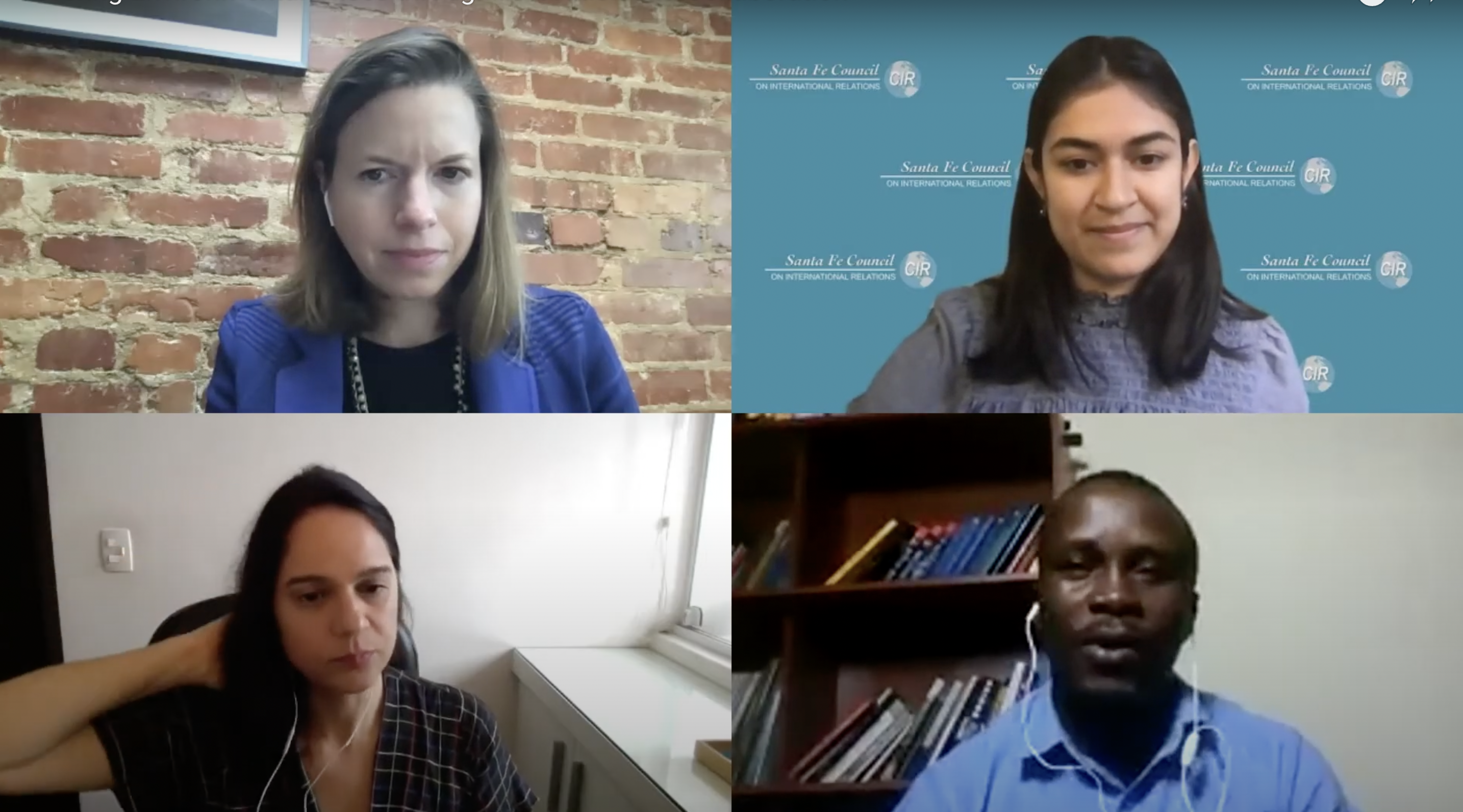Journalist Resource December 9, 2020
On-Demand Webinar: Innovative and Collaborative Approaches to Environmental Reporting

In collaboration with the Santa Fe Council on International Relations, the Pulitzer Center hosted a discussion exploring how journalists are using innovation and strategic partnerships to generate more impactful environmental reporting across the globe. The panel on December 2 featured Pulitzer Center grantees Eliza Barclay of Vox, Juliana Mori of InfoAmazonia, and Fredrick Mugira of InfoNile and Water Journalists Africa. The discussion was moderated by Pulitzer Center Rainforest Journalism Fund Manager Nora Moraga-Lewy, as part of the Santa Fe Council on International Relations' Journalism Under Fire conference.
Innovative Approaches to Environmental Reporting
Barclay discussed her award-winning, Pulitzer Center-supported project, These Trees Are Climate Superheroes, which engaged viewers in an interactive multimedia format to explore the ecological benefits of key tree species in Brazil, Indonesia, and the Congo. She said that engaging visuals such as drone footage were crucial in portraying the subject most effectively, especially since the ecological services of forests are often overlooked as climate solutions.
“A part of this project was to really bring people there and help them appreciate the magic and beauty and grandeur of these forests,” Barclay said.
Mori presented on InfoAmazonia’s award-winning project, Suffocated Amazon, which uses data journalism to portray thousands of illegal forest fires in the Amazon and their harmful impacts on Indigenous communities through an interactive map. Deforestation rates in the Amazon have been at an all-time high in 2019 and 2020, and InfoAmazonia’s Pulitzer Center-supported work is instrumental in documenting the crisis. The project also employs a Twitter bot to publicly report the most threatened Amazonian lands daily and weekly, based on the team’s findings.
“This project was a way to monitor the environmental crisis we are living in, especially in the Amazon,” Mori said.
Mugira discussed his work with InfoNile, a media organization he co-founded in 2016 that uses geo-journalism and data-based multimedia storytelling to uncover critical stories on water issues in the Nile River Basin. His Pulitzer Center-supported project, Coronavirus in Nile Basin: Dual Dangers of a Pandemic and Water Crisis, takes an innovative approach in exploring how different communities in the Nile Basin are tackling water sanitation and accessibility issues during the pandemic.
Collaboration to Increase Reader Accessibility
A common theme during the discussion was the importance of collaboration in environmental reporting to increase the accessibility, engagement, and accuracy of stories for their intended audiences.
For Vox’s These Trees Are Climate Superheroes project, collaborating with local scientists in the Amazon, Indonesia, and the Congo was essential to understand and properly communicate the trees’ “superpowers,” such as carbon sequestration and maintenance of rainfall cycles. Barclay’s team also collaborated with their Vox colleagues, testing to see how accessible and understandable they found the content.
InfoAmazonia’s project, Suffocated Amazon, also employed user-testing and design-thinking processes, especially listening to feedback from Indigenous organizations on the accessibility of their reporting. This feedback was particularly useful in improving the language that the Twitter bot uses when documenting the status of forest fires in different Amazonian regions. Mori’s team also collaborated with local Indigenous communities to supplement their data findings with human-centered stories.
“We’ve been able to take the stories back to the communities,” said Mori, adding that it’s important for these stories to reach the Indigenous communities impacted most.
InfoNile is no stranger to journalistic collaboration, working with journalists across 50 countries in Africa. For Coronavirus in Nile Basin: Dual Dangers of a Pandemic and Water Crisis, Mugira and his team supported 32 journalists in the region to cover COVID-19’s impact on the water supply of vulnerable communities. Journalists for Mugira’s project worked in pairs—one newspaper or TV journalist based in an urban setting working with a local, often rural-based radio journalist—in order to pool their knowledge and produce more nuanced stories tailored to their unique audiences.
Environmental Journalism’s Next Big Topics
Barclay said the supertrees project instilled in her the importance of environmental stories centered around conservation and preserving biodiversity as climate solutions. In fact, Barclay’s team will be launching a project soon to increase Vox’s biodiversity coverage in 2021.
“We want to help people understand why our ecosystems and the diversity within our ecosystems are so important,” Barclay said. “We tend to focus on individual species, but it’s the relationships between species and ecosystems that are critically so important.”
Mori said she also finds biodiversity to be an essential topic for media outlets to report on in the future, and her InfoAmazonia team plans to continue exploring the intersection of increasing Amazon fires and air pollution in Brazil’s cities. She hopes that by focusing on how deforestation impacts Brazilians in all regions of the country, more national attention will be given to the Amazon’s environmental crisis.
By partnering his grantees with local, rural journalists, some of Mugira’s projects uncovered how certain Nile Basin communities, particularly in Ethiopia and Northern Uganda, actually have had increased water supplies since the pandemic began because local governments provided more water aid and constructed water holes in hopes of reducing COVID-19 transmission. This was an eye-opening discovery, and Mugira hopes more stories will explore the overlooked impacts of COVID-19 on communities’ water supplies.
Moraga-Lewy’s concluding remarks summarized the takeaways from this discussion best: “We came into this session knowing that environmental issues and crises are very complex, and that there can be many challenges in trying to communicate specific information. But we have also seen that there are many innovations and approaches that journalists are taking in order to address these challenges.”
